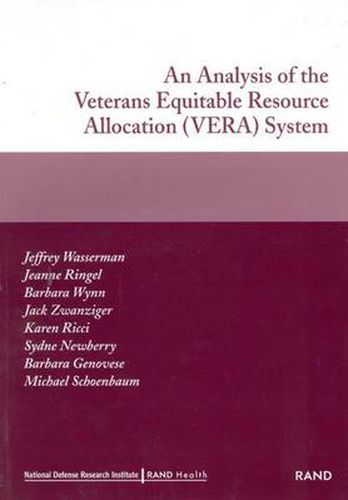Readings Newsletter
Become a Readings Member to make your shopping experience even easier.
Sign in or sign up for free!
You’re not far away from qualifying for FREE standard shipping within Australia
You’ve qualified for FREE standard shipping within Australia
The cart is loading…






Since April 1997, the Veterans Equitable Resource Allocation (VERA) System has served as the basis for allocating the congressionally appropriated medical care budget of the Department of Veterans Affairs (DVA) to its regional networks. Concerned that the VERA system may not allocate resources in a manner consistent with its mission, Congress requested a study of the system and how allocations are affected by a number of factors, including infrastructure age, extreme weather conditions, and participation in medical education. This report describes the results of RAND’s initial analysis. Because of the project’s short time frame, only qualitative analysis was performed. Among the findings were that health care delivery costs may be affected by the age, physical condition, and historical significance of a VISN’s capital infrastructure, factors for which VERA does not currently adjust. An additional finding was that VERA’s current case-mix adjustment may not adequately account for differences in the average health status of veterans across networks. The influence on costs and access to care of factors such as weather extremes was less clear. In spite of its possible shortcomings, VERA appeared to be designed to meet its objectives more closely than did previous VA budget allocation systems. A plan was presented for further quantitative analysis of a number of critical issues that emerged from the current study.
$9.00 standard shipping within Australia
FREE standard shipping within Australia for orders over $100.00
Express & International shipping calculated at checkout
Since April 1997, the Veterans Equitable Resource Allocation (VERA) System has served as the basis for allocating the congressionally appropriated medical care budget of the Department of Veterans Affairs (DVA) to its regional networks. Concerned that the VERA system may not allocate resources in a manner consistent with its mission, Congress requested a study of the system and how allocations are affected by a number of factors, including infrastructure age, extreme weather conditions, and participation in medical education. This report describes the results of RAND’s initial analysis. Because of the project’s short time frame, only qualitative analysis was performed. Among the findings were that health care delivery costs may be affected by the age, physical condition, and historical significance of a VISN’s capital infrastructure, factors for which VERA does not currently adjust. An additional finding was that VERA’s current case-mix adjustment may not adequately account for differences in the average health status of veterans across networks. The influence on costs and access to care of factors such as weather extremes was less clear. In spite of its possible shortcomings, VERA appeared to be designed to meet its objectives more closely than did previous VA budget allocation systems. A plan was presented for further quantitative analysis of a number of critical issues that emerged from the current study.